Kanji for Sun or Day 日 (Hi or Nichi)
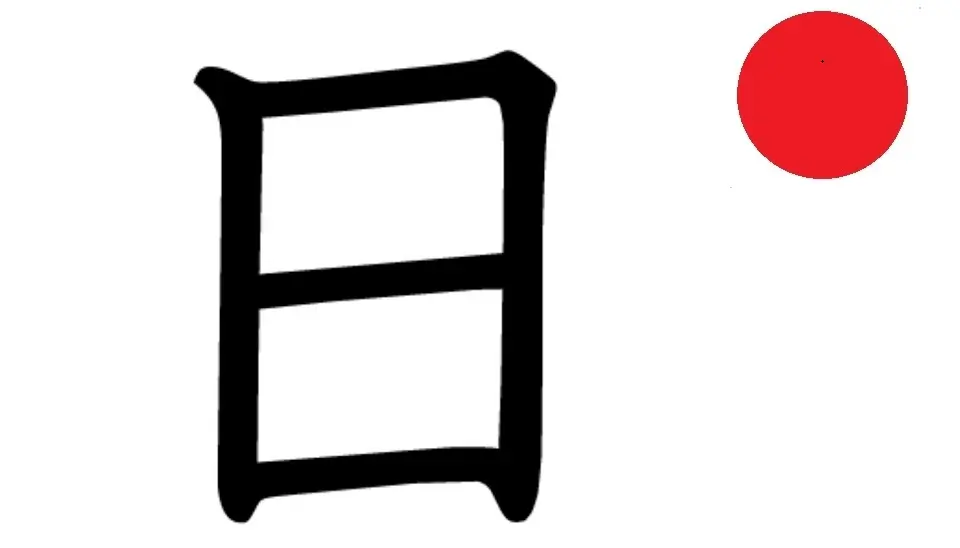
The kanji for “sun” in Japanese is 日. The pronunciation of 日 is “hi” in its kun’yomi reading and “nichi” or “jitsu” in its on’yomi reading. However, please remember that the pronunciation of the kanji 日 can be different (hi, ka, nichi, bi, etc.) depending on the word and context.
Sun’s Kanji 日 is constructed with 4 strokes. This Kanji is a part of the JLPT N5 syllabus (please check the JLPT N5 Kanji list). In Japanese schools, this Kanji is taught in grade 1.
Not Just the Sun, But the Kanji for Day
Please note that the kanji 日 is also a kanji for “day.” This is largely because of ancient people’s understanding of natural phenomena and the association of the sun with a single day.
In ancient societies, time was often measured by natural phenomena. These natural phenomena can be celestial bodies like the sun and moon rising and setting. The duration from one sunrise to the next constitutes a single day. Therefore, the sun became naturally associated with a day.
Thus, in the character system, the symbol for the sun came to represent not just the celestial body itself but also the associated period. This is a good example of how cultural and societal contexts influence language development.
As a standalone character, the Kanji of the sun is commonly used in words like 日曜日 (“nichiyoubi“, meaning Sunday) or 日本 (Nippon/Nihon, meaning Japan, the origin of the sun).
Please also note that we talk about the sun as a celestial body, or in more formal and scientific terms, the sun is represented by another Kanji 太陽 (taiyō).
Origin of the Sun’s Kanji 日
The shape of this kanji is believed to be derived from a circular pictogram that represents the sun. Over time, this circular shape was simplified and stylized into a rectangular shape, resulting in the current form, i.e., 日.
Please refer to the following image to see how the sun’s kanji evolved as it appeared in Oracle Bone Script, Bronze inscription, small seal script, and how we write it in the present:
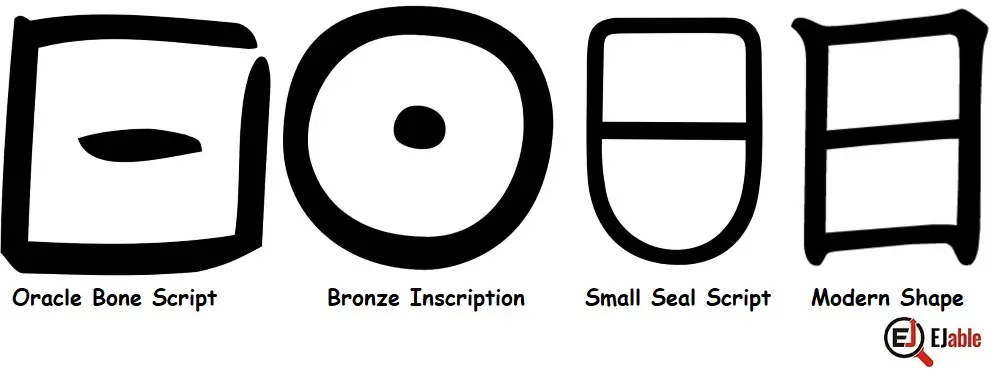
Mnemonic: How to Remember the Sun or Day’s Kanji (日)?
To remember the kanji 日, you can think of it as a stylized representation of a sunrise, where the horizontal lines represent the horizon.
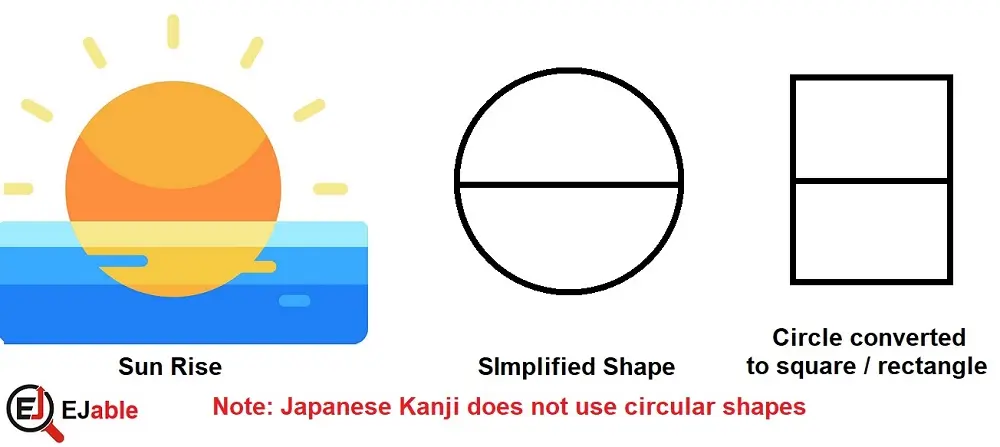
Explanation of the evolution of the Kanji 日 from the above picture:
The first figure in the above picture shows a sun rising over the horizon. If we pick up the circle divided by a horizontal line representing the horizon, we get the second figure on the right-hand side.
However, as Japanese Kanji characters do not use circular shapes, we must convert the circle to a square. You can check this in the article about remembering Kanji under the “Important Points While Learning Kanji.”
Now, a question may arise as to why the Kanji of the ‘Sun’ is not square but a rectangle.
The reason is simple: if we wish to draw a square shape with a horizontal line in the middle, we need more accuracy to locate the center. However, even if the line in the middle is slightly up or down in a rectangular shape, it does not look very odd.
Stroke Order for the Kanji 日
The following illustrations show the stroke order to write the Kanji 日, meaning “Sun”:
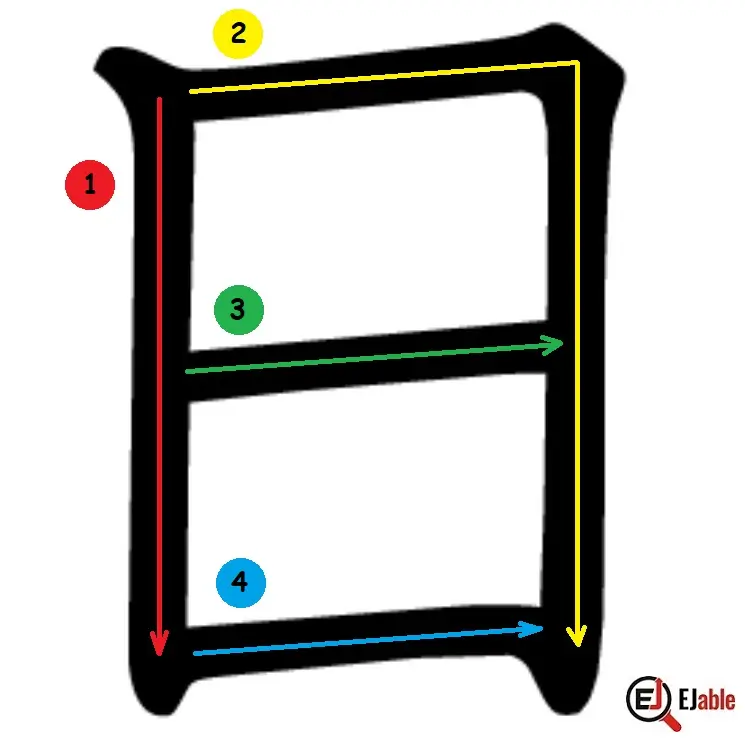
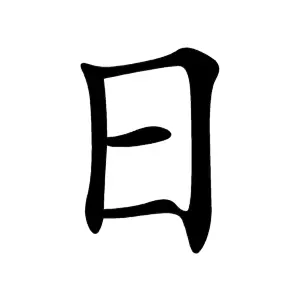
Sun’s Kanji 日 as a Radical
When used as a Kanji radical, 日 can retain its meaning related to the sun or days. However, it can also serve as a phonetic component, contributing to the pronunciation of the whole character.
Overall, Kanji 日 appears as a radical or as a component in 1481 Kanji characters, including 219 Jōyō Kanji.
Examples of 日 as a radical
Following are some examples of kanji where 日 (sun or day) appears as a radical:
- 明 (mei, “bright”): This Kanji combines the radicals for “sun” (日) and “moon” (月). This combination suggests brightness or clarity as if illuminated by both celestial bodies.
- 時 (ji, “time”): Here, the 日 radical combines with 寺 (temple). This combination suggests the concept of time, possibly relating to the disciplined, timely practices at temples.
- 曜 (you, “weekday”): In this character, the 日 radical is combined with other elements. Together, they form a character representing the days of the week, keeping the time-related concept.
- 晩 (ban, “evening”): This kanji combines the “sun” radical with 免. The image of the sun radical helps represent a time of day, in this case, evening.
- 早 (hayai, “early” or “fast”): This Kanji includes the “sun” radical and the ten 十. However, in this case, we can consider this shape a sprouting plant and might represent something “growing quickly,” forming an image of the sun rising early.
- 旭 (asahi, “morning sun” or “rising sun”): We will discuss this kanji in a separate article.
These examples illustrate how the radical of Sun’s Kanji (日) can contribute to the meaning or pronunciation of a kanji. As always, the context and the other elements of the kanji character can influence its overall meaning and pronunciation.
日’s Use in Language
While the Kanji 日 denotes “Sun” or “Day”, its use extends to various compound words and expressions describing a connection with the Sun. There are 535 Japanese words that begin with the Kanji 日, and it appears in 1230 words.
Examples of Kanji 日 in Compounded Kanji Characters
Following are the examples where Kanji 日 appears in Japanese compounded Kanji characters:
- 日光 (にっこう, Nikkō): Sunlight.
- 日本 (にほん/にっぽん, Nihon/Nippon): Japan (literally “origin of the sun,” hence “Land of the Rising Sun”).
- 日曜日 (にちようび, nichiyōbi): Sunday.
- 日常 (にちじょう, nichijō): Everyday, daily.
- 日記 (にっき, nikki): Diary.
- 日程 (にってい, nittei): Schedule, program.
- 日中 (にっちゅう, nicchū): Daytime.
- 日没 (にちぼつ, nichibotsu): Sunset.
- 日差し (ひざし, hizashi): Sunbeam, sunlight.
- 日付 (ひづけ, hizuke): Date (as in calendar date).
- 日暮らし (ひぐらし, higurashi): Day-to-day living.
- 日和 (ひより, hiyori): Weather (often used in the context of good weather).
- 日向 (ひなた, hinata): Sunny place, in the sun.
- 日帰り (ひがえり, higaeri): Day trip.
- 日照り (ひでり, hideri): Drought, dry weather.
These compound words highlight the various ways Sun’s kanji 日 is used. These usages reflect its importance not just in representing the physical sun but also in terms of time, weather, and everyday life in Japanese culture.
Cultural Context of Sun or Sun’s Kanji in Japan
The kanji for the sun, 日 (にち, nichi or ひ, hi), holds profound cultural and symbolic significance in Japan. Therefore, it is deeply embedded in various aspects of Japanese life and identity.
National Identity:
Perhaps the most prominent cultural significance of 日 is its representation of Japan. The country’s name, 日本 (Nihon or Nippon), means “origin of the sun” or “Land of the Rising Sun,” a reference to Japan’s location to the east of the Asian continent, from where the sun rises.
This symbolism is deeply ingrained in the national identity. It is reflected in the national flag, known as “日の丸” (Hinomaru), which depicts a red circle symbolizing the sun against a white background.
Shinto Religion:
In Shinto, the native religion of Japan, the sun goddess Amaterasu is one of the most important deities. She is considered the ancestor of the Imperial Family and a central figure in Japanese mythology, particularly in the story of her retreat into a cave, which plunged the world into darkness, and her eventual emergence, which brought light back to the world.
Agricultural Significance:
Historically, the sun has been crucial in agriculture, a vital part of Japanese life. Festivals and rituals related to rice planting and harvesting often involve prayers for sunshine and good weather, reflecting the sun’s role in sustaining life.
Japanese Art and Literature:
The sun appears frequently in Japanese art, poetry, and literature, often symbolizing life, energy, renewal, and hope. The imagery of the rising sun is especially popular, representing new beginnings and perpetual renewal.
Daily Life and Language:
The sun’s kanji, 日, is used extensively in Japanese, forming words related to daily life, time, and nature. It’s fundamental in expressing days, dates, and weather conditions.
Solar Observances:
Traditional Japanese observances, like the adoration of the first sunrise of the New Year (初日の出, hatsuhinode), underscore the sun’s cultural importance. Witnessing the first sunrise is a popular activity, symbolizing the hope and renewal that comes with the start of a new year.
In summary, 日 is more than just a character in the Japanese writing system; it’s a symbol with deep roots in the nation’s mythology, religion, natural environment, and national identity. It encapsulates the reverence for nature and the cosmos, a hallmark of Japanese culture.
Do check other Kanji characters on the page “How to Remember Kanji. “

A long-term ex-pat in Japan, Himanshu comes with an IT background in SAP consulting, IT Business Development, and then running the country operations of an IT consulting multinational. Himanshu is the co-founder and Managing Director of ReachExt K.K. and EJable.com. He is also an Advisory Board Member of a Silicon Valley AI/IoT startup.
